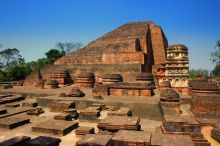Nalanda University
 | |
|---|---|
| Type | Public International University |
| Motto | Neti Neti (Not this, Not this) |
| Established | Ancient (5th century CE), Revived (2010) |
| Founder | Kumaragupta I (original), Government of India (modern) |
| Chancellor | Prof. Arvind Panagariya |
| Vice-Chancellor | Prof. Abhay Kumar Singh (Acting) |
| Location | Rajgir, Bihar, India |
| Campus | Rural, 455 acres |
| Affiliations | UGC |
| Website | Official Website |
Nalanda University is regarded as one of the world’s first residential universities, located in Rajgir, Bihar, India. Established in the 5th century CE during the reign of Gupta emperor Kumaragupta I, it became a premier seat of Buddhist studies, philosophy, mathematics, astronomy, medicine, and other sciences. At its peak, Nalanda housed over 10,000 students and 2,000 teachers, attracting scholars from China, Tibet, Korea, Mongolia, and Central Asia.
The university declined after repeated invasions and was destroyed by Bakhtiyar Khilji in the 12th century CE. Its ruins were rediscovered in the 19th century and were inscribed as a UNESCO World Heritage Site in 2016. In modern times, Nalanda University was revived through the Nalanda University Act, 2010 and continues as an international institution of higher learning.
History
Nalanda was founded around 427 CE under the Gupta dynasty. Its vast library, Dharma Gunj (Mountain of Truth), held hundreds of thousands of manuscripts. Famous Chinese monk Xuanzang studied and taught here, recording valuable accounts of ancient India. The university remained active for nearly 700 years until its decline due to political instability and invasions.
Revival
In 2006, former President Dr. A. P. J. Abdul Kalam proposed reviving Nalanda as an international institution. The Parliament of India passed the Nalanda University Act in 2010, and the university became operational in 2014. The revival was supported by the East Asia Summit countries, including Japan, China, Singapore, and Thailand.
Academics
Nalanda University currently offers postgraduate and doctoral programs in:
- Buddhist Studies, Philosophy and Comparative Religion
- Historical Studies
- Ecology and Environmental Studies
- Sustainable Development and Management
- Languages and Literature
- International Relations and Peace Studies
Campus
The new eco-friendly campus spans 455 acres in Rajgir, designed with sustainable architecture inspired by Buddhist principles and the layout of ancient Nalanda.
Governance
Nalanda is governed by an international board of trustees.
- Chancellor: Prof. Arvind Panagariya
- Vice-Chancellor (Acting): Prof. Abhay Kumar Singh
International Collaboration
Several Asian countries actively support the university’s academic and cultural programs. Japan funded major infrastructure projects, while China and Thailand contributed to academic exchanges.
UNESCO World Heritage
In 2016, the ruins of ancient Nalanda Mahavihara were declared a UNESCO World Heritage Site for their historical, cultural, and architectural significance. The site includes monasteries, temples, sculptures, and inscriptions that showcase India’s ancient educational excellence.
Legacy
Nalanda is often described as the **“Oxford of Ancient India”**. It symbolizes India’s intellectual traditions, intercultural dialogue, and global impact on education. The university’s heritage continues to inspire scholars, policymakers, and students worldwide.
See Also
- Takshashila
- Vikramashila
- University Grants Commission (India)
- Buddhism in India
- Education in Ancient India
References
- UNESCO World Heritage Centre. Archaeological Site of Nalanda Mahavihara.
- Government of India. Official Website of Nalanda University.
- Xuanzang (Hsüan-tsang). Great Tang Records on the Western Regions (7th century).
- Amartya Sen (2005). The Argumentative Indian. Penguin Books.
- Sinha, B.P. (1995). Nalanda: Its History and Ruins. Archaeological Survey of India.

